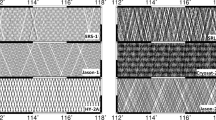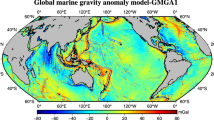Abstract
In recent years, the satellite altimeter technology allows to enhance the marine investigation in any area. Up to now, many scientific studies have attempted to improve the accuracy and resolution of altimeter-derived gravity anomalies and have produced a gravity grid with interval of 1' × 1' for most the oceans all over the world. However, this gravity anomalies are not very high accuracy and have a large difference compared to shipboard gravity anomalies, especially in the coastal and islands areas. The purpose of this article is to improve the accuracy of altimeter-derived marine gravity anomalies for geological structure research in the Vietnam South-Central continental shelf and adjacent areas. The least squares collocation method is used to correct the altimeter-derived marine gravity data based on the shipboard gravity data in order to improve the accuracy of marine gravity anomalies. In this article, the altimeter-derived marine gravity anomalies are taken from Sandwell, D. T., et al., (V24.1) and the shipboard gravity anomalies are from the surveyed projects between Vietnam, Russia and other countries. Here, comparison of both those data has brought a mean-squared error is about ±9.358 mGal. After correcting, the mean-squared error between the corrected-altimeter-derived marine gravity and shipboard gravity anomalies are improved from ±9.358 to ±1.208 mGal (for the altimeter data coincided with shipboard track). Also, in this article, the Cenozoic sedimentary density and thickness are determined through the 3D interpretative methods of the above-corrected gravity anomalies in combination with seismic data. The achieved results realize how the efficiency and actuality of the corrected-altimeter-derived marine gravity anomalies for the detailed researches of geological structures. Especially, it is more meaningful in the remote or sparsely surveyed regions.








Similar content being viewed by others
REFERENCES
M. H. P. Bott, “The use of rapid digital computing methods for direct gravity interpretation of sedimentary basins,” Geophys. J. Roy. Astr. Soc. 3 (1), pp. 63–67 (1960).
Bui Cong Que, Tran Tuan Dung et al., Construction of National atlas for characteristics on the natural conditions and environment in the sea areas of Vietnam. State level project. National program for marine research KC-09-02 (2005).
G. O. David and N. P. A. Bhrigu, “3DINVER.M: a MATLAB program to invert the gravity anomaly over a 3D horizontal density interface by Parker–Oldenburg’s alogorithm,” J. Comp. Geosci. 31 (4), 513–520 (2005).
R. Forsberg and C. C. Tscherning, Geodetic Gravity Field Modelling Programs (University of Copenhagen, Copenhagen, 2008) .
Geosoft. The Montaj GM-SYS 3D Modelling Extension Requires Geosoft’s Oasis Montaj (2009).
http://bgi.obs-mip.fr/data-products/Gravity-Databases/Marine-Gravity-data.
M. T. Huang, G. J. Zhai, Y. Z. Ouyang, et al., “Recovery of marine gravity field using integrated data from multi-satellite missions,” Sci. Surv. Mapp. 31 (6), 37–39 (2006).
R. G. Kulinich, A. A. Zabolotnikov, Yu. D. Markov, A. V. Zhuravlev, V. V. Zdorovenin, A. A. Golovan, A. I. Obzhirov, and N. A. Nikolaeva, Formation and Evolution of the Earth Crust in the South China Sea and in the Southeast Asia (Publishing House Nauka, Moscow, 1994).
Nguyen Trong Tin, Tran Tuan Dung, et al., “Tectonic characteristics of Cenozoic basins in the East Vietnam Sea based on new studied results,” International conference on Science and technology—35 years of Vietnam Petroleum (2010), pp. 57–73.
D. W. Oldenburg, “The inversion and interpretation of gravity anomalies,” Geophys. 39 (4), 526–536 (1974).
Ole Baltazar Andersen, Per Knudsen, and Philippa A. M. Berry, “The DNSC08GRA global marine gravity field from double retracked satellite altimetry,” J. Geodesy 84 (3), 191–199 (2010). https://doi.org/10.1007/s00190-009-0355-9
R. L. Parker, “The rapid calculation of potential anomalies,” Geophys. J. R. Astronom. Soc. 31, 447–455 (1973).
D. T. Sandwell and W. H. F. Smith, “Marine gravity anomaly from Geosat and ERS-1 satellite altimetry,” J. Geophys. Res. 102, 10039–10054 (1997).
D. T. Sandwell and W. H. F. Smith, “Global marine gravity from retracted Geosat and ERS-1 altimetry: ridge segmentation versus spreading rate,” J. Geophys. Res. 114, B01411 (2009). https://doi.org/10.1029/2008JB006008
D. T. Sandwell, E. Garcia, K. Soofi, P. Wessel, and W. H. F. Smith, “Towards 1 MGal global marine gravity from CryoSat-2, Envisat, and Jason-1,” The Leading Edge 32 (8), 892–899 (2013). https://doi.org/10.1190/tle32080892.1
D. T. Sandwell, R. D. Muller, W. H. F. Smith, E. Garcia, and R. Francis, “New Global marine gravity model from CryoSat-2 and Jason-1 reveals buried tectonic structure,” Science 346 (6205), 65–67 (2014). doi: 10.1 126/science.1258213 State level project. National program for marine research KC-, 09–02.
T. D. Tran, “Characteristics of structure—tectonic in the deep water of the East Sea of Vietnam based on interpretation of gravity and magnetic anomaly data,” The 35th Conference of Vietnam Petroleum Institute, (2013), pp. 55–66.
T. D. Tran, C. Q. Bui, and Nguyen Ho Phu, “Cenozoic basement structure of the South China Sea and adjacent areas by modeling and interpreting gravity data,” Russ. J. Pac. Geol. 13 (4), 227–236 (2013).
C. C. Tscherning and R. H. Rapp, Closed Covariance Expressions for Gravity Anomalies, Geoid Undulations, and Deflections of the Vertical Implied by Anomaly Degree Variance Models. Reports of the Department of Geodetic Science. Vol. 208. (Ohio State Univ., Columbus, 1974).
Geol. Petrol. Resources of Vietnam (Vietnam Oil and Gas Corporation, 2012).
S. Zhang, D. T. Sandwell, J. Taoyong, and L. Dawei, “Retracking of SARAL/AltiKa radar altimetry waveforms for optimal gravity field recovery,” Marine Geodesy, (2016). https://doi.org/10.1080/01490419.2016.1265032
ACKNOWLEDGMENTS
This research was supported by the VT-UD.03/17-20 Project, VAST’s Project nos. VAST06.01/18-19 and ĐLTE00.09/18-19.
Author information
Authors and Affiliations
Corresponding authors
Additional information
Recommended for publishing by V. B. Kaplun
Rights and permissions
About this article
Cite this article
Tran Tuan Dung, Kulinich, R.G., Van Sang, N. et al. Improving Accuracy of Altimeter-derived Marine Gravity Anomalies for Geological Structure Research in the Vietnam South-Central Continental Shelf and Adjacent Areas. Russ. J. of Pac. Geol. 13, 364–374 (2019). https://doi.org/10.1134/S181971401904002X
Received:
Revised:
Accepted:
Published:
Issue Date:
DOI: https://doi.org/10.1134/S181971401904002X




